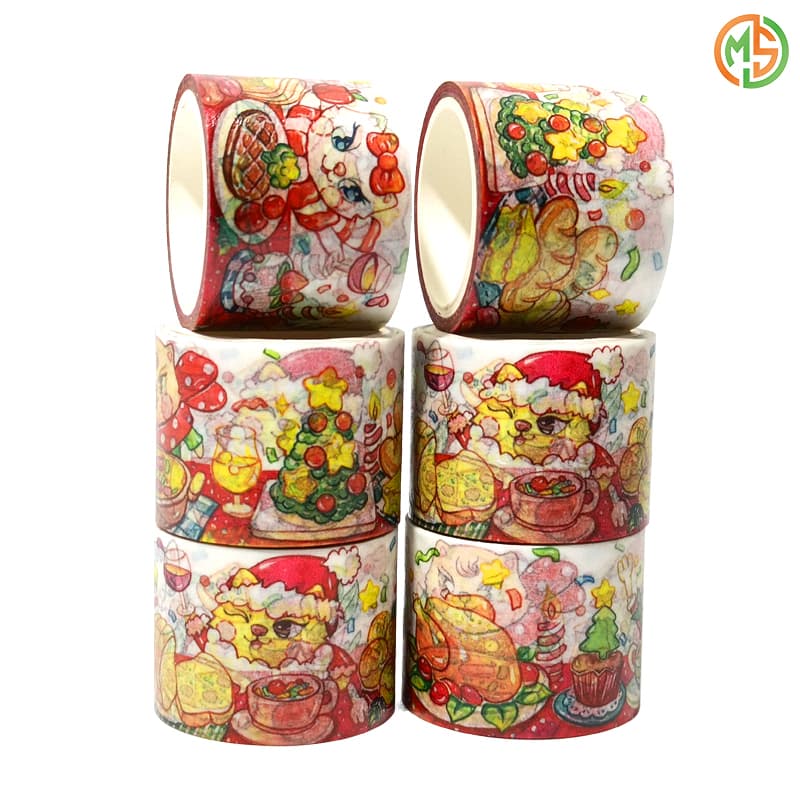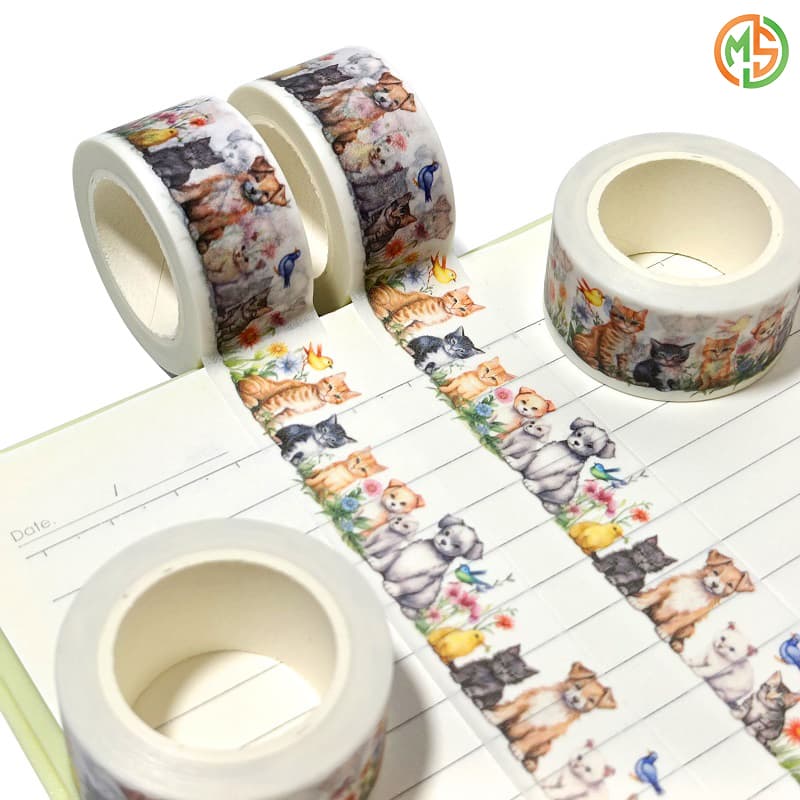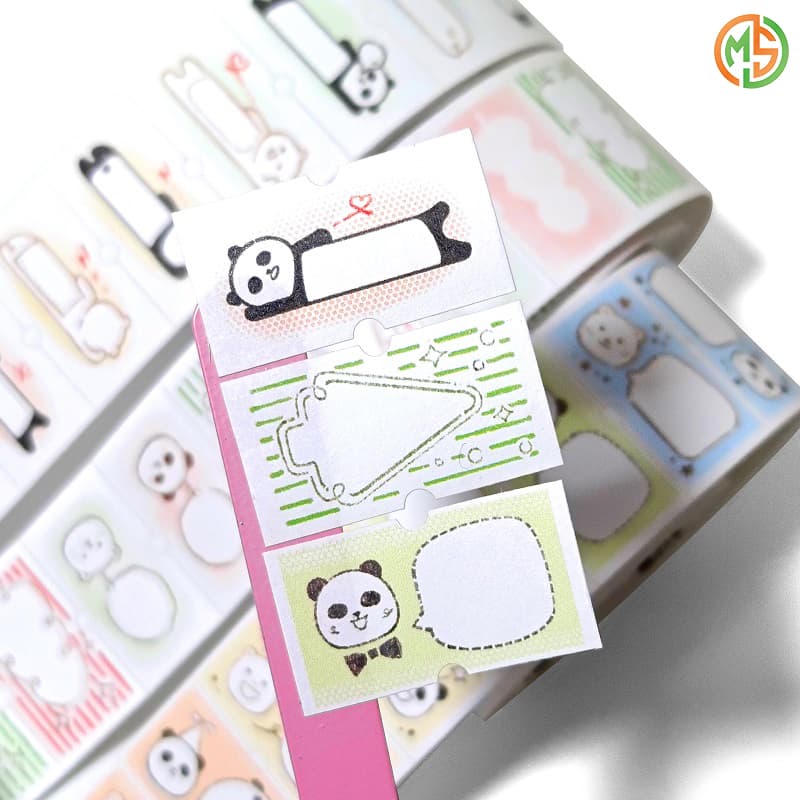Washi tape wholesale is based on paper and is paired with a relatively mild pressure-sensitive adhesive. This structure gives it some characteristics that are different from ordinary tapes. First, its viscosity is moderate, which allows it to be stably attached to the surface of an object for a certain period of time, but it does not produce extremely strong adhesion like strong tape. Secondly, washi tape is usually easy to tear by hand. During the operation, it can be easily cut into the appropriate length and shape according to needs without the help of scissors and other tools, which brings great convenience to decoration work. Moreover, the surface of washi tape is printed with various exquisite patterns, ranging from simple lines to complex patterns of flowers, animals, etc., which can meet the aesthetic needs of different users and add a unique artistic atmosphere to wall decoration.

washi tape custom print Test in advance: Before using washi tape to decorate the wall in a large area, be sure to conduct a small-scale test in an inconspicuous location on the wall (such as a corner). Paste the washi tape on the test area, keep it for 24-48 hours, and then slowly tear it off to observe whether there are glue stains, peeling or discoloration on the wall. If the test results are good, then proceed with large-scale construction; if there are problems, you need to carefully consider whether to continue using it or choose other decoration methods.
Pasting method: When pasting washi tape, try to avoid pressing hard, and just gently stick the tape on the wall. If the tape is not pasted evenly, bubbles or wrinkles are generated, you can use a soft cloth or card to start from one end of the tape and gently smooth it to the other end to remove the bubbles. At the same time, pay attention to keeping the tape horizontal or vertical during the pasting process, and use tools such as a level to assist to ensure the beauty of the decorative effect.
Duration of use: Although the adhesiveness of washi tape is relatively mild, if it is pasted on the wall for a long time (more than 3 months), the adhesive layer may gradually penetrate into the wall over time, especially in a humid and high temperature environment, this phenomenon may be more obvious, thereby increasing the difficulty of removal and the risk of damage to the wall. Therefore, if it is a short-term decoration demand, such as holiday decoration, temporary exhibition, etc., washi tape is a good choice; if the decorative effect is expected to last for a long time, it is recommended to use it with caution or change the position of the tape regularly.
Removal method: When it is necessary to remove the washi tape, it should be gently torn off in the direction parallel to the wall. If the tape is difficult to tear off or there are residual glue stains, do not tear it off forcibly to avoid damaging the wall. At this time, you can use a hair dryer to heat the tape at a low temperature to soften the glue layer, and then slowly tear it off. For residual glue stains, you can gently wipe it with an eraser, or use a special cleaner, but before using the cleaner, you also need to test it on a small area to ensure that the cleaner will not cause corrosion or discoloration on the wall.

Die cut washi tape Latex paint wall: Washi tape can generally be pasted smoothly on smooth and flat latex paint walls. Since the texture of latex paint walls is relatively tight, the stickiness of the washi tape can work well, and if it is removed after a short period of pasting (1-3 months), as long as the operation is done properly, it usually does not cause obvious damage to the wall, and it is not easy to leave residual glue. However, if the latex paint on the wall is of poor quality, with problems such as powdering and peeling, pasting washi tape may aggravate these problems, and the wall skin may even peel off when the tape is removed.
Wallpaper wall: If the wallpaper is a tougher type such as non-woven fabric, washi tape can also be applied to a certain extent. However, be careful not to press too hard when pasting to prevent the stickiness of the tape from penetrating into the wallpaper and affecting future removal. For wallpapers with smoother surfaces such as PVC, washi tape may have a better pasting effect. However, if it is pure paper wallpaper, especially some thin and fragile pure paper wallpaper, the pasting of washi tape may cause damage to it, and it is easy to damage the wallpaper surface or leave marks when it is torn off.
Tile wall: The surface of the tile is smooth and hard, and the washi tape can adhere to it well, and it is relatively easy to remove, and there are fewer residual glue stains. Whether it is used to decorate the tile wall of the kitchen and bathroom, or the tile background wall of the living room, washi tape can play its decorative role, such as using it to paste some lightweight decorative paintings, photos, etc.
Special wall materials: Wall materials such as diatom mud and artistic paint (such as texture paint) have special textures or relatively loose textures on their surfaces. After pasting, washi tape may sink into the texture, making it difficult to remove, and it is very likely to destroy the texture structure or surface coating of the wall when it is torn off. For lime walls, old walls with severe powdering, and untreated rough walls, even if washi tape can be barely pasted, it may cause problems such as wall skin peeling when torn off due to the instability of the wall. Therefore, it is not recommended to use it on such walls.


 Español
Español English
English Français
Français Deutsch
Deutsch Italiano
Italiano Español
Español







 IPv6 RED SOPORTADA
IPv6 RED SOPORTADA
